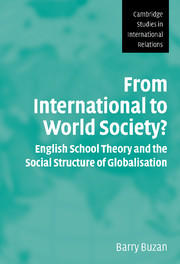 From International to World Society?
From International to World Society? Book contents
- Frontmatter
- Contents
- List of figures and tables
- Preface
- List of abbreviations
- Glossary
- Introduction
- 1 English school theory and its problems: an overview
- 2 World society in English school theory
- 3 Concepts of world society outside English school thinking
- 4 Reimagining the English school's triad
- 5 Reconstructing the pluralist–solidarist debate
- 6 The primary institutions of international society
- 7 Bringing geography back in
- 8 Conclusions: a portrait of contemporary interstate society
- List of references
- Index
- CAMBRIDGE STUDIES IN INTERNATIONAL RELATIONS
6 - The primary institutions of international society
Published online by Cambridge University Press: 14 January 2010
- Frontmatter
- Contents
- List of figures and tables
- Preface
- List of abbreviations
- Glossary
- Introduction
- 1 English school theory and its problems: an overview
- 2 World society in English school theory
- 3 Concepts of world society outside English school thinking
- 4 Reimagining the English school's triad
- 5 Reconstructing the pluralist–solidarist debate
- 6 The primary institutions of international society
- 7 Bringing geography back in
- 8 Conclusions: a portrait of contemporary interstate society
- List of references
- Index
- CAMBRIDGE STUDIES IN INTERNATIONAL RELATIONS
Summary
The debate about pluralism and solidarism leads into the question of the institutions of international society. It seems safe to say that there will be a close relationship between where an international society is located on the pluralist–solidarist spectrum, and either what type of institutions it has, or how it interprets any given institution. A number of authors have, for example, tracked the evolution of sovereignty, relating it, inter alia, to changes in the internal character of the dominant states (Keohane 1995; Reus-Smit 1997; Barkin 1998; Sørensen 1999). The concept of institutions is central to English school thinking for three reasons: first, because it fleshes out the substantive content of international society; second, because it underpins what English school writers mean by ‘order’ in international relations; and third, because the particular understanding of institutions in English school thinking is one of the main things that differentiates it from the mainstream, rationalist, neoliberal institutionalist, study of international regimes. Quite a bit has been written about the similarities and differences between the English school approach to institutions and that of regime theory (Keohane 1988; Hurrell 1991; Evans and Wilson 1992; Buzan 1993; Wæver 1998: 109–12; Alderson and Hurrell 2000). There is general agreement that these two bodies of literature overlap at several points, and that there is significant complementarity between them. The essential differences are:
(1) regime theory is more focused on contemporary events while the English school has a mainly historical perspective;
[…]
- Type
- Chapter
- Information
- From International to World Society?English School Theory and the Social Structure of Globalisation, pp. 161 - 204Publisher: Cambridge University PressPrint publication year: 2004
- 2
- Cited by


